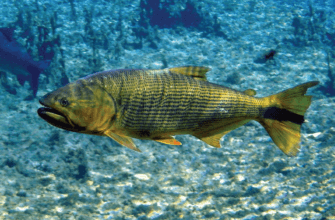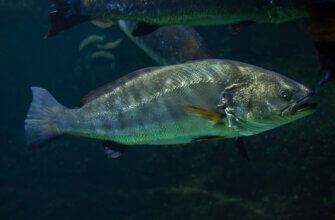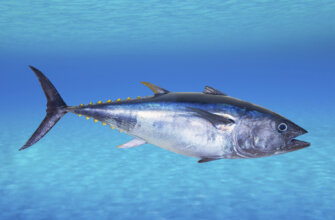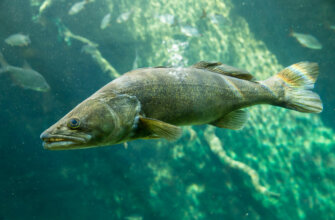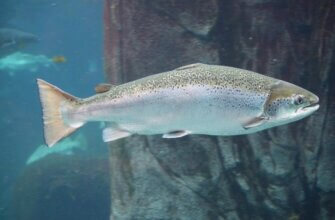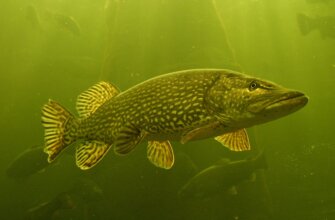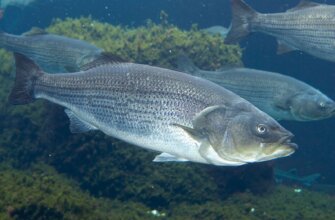Trout are a type of freshwater fish that belong to the salmon family. They are known for their excellent taste and are popular among anglers for sport fishing. There are several species of trout, including rainbow, brown, brook, cutthroat, and lake trout.
Trout are typically found in cool, clear streams and rivers, although some species can also be found in lakes and ponds. They are carnivorous and feed on a variety of aquatic insects, small fish, and crustaceans.
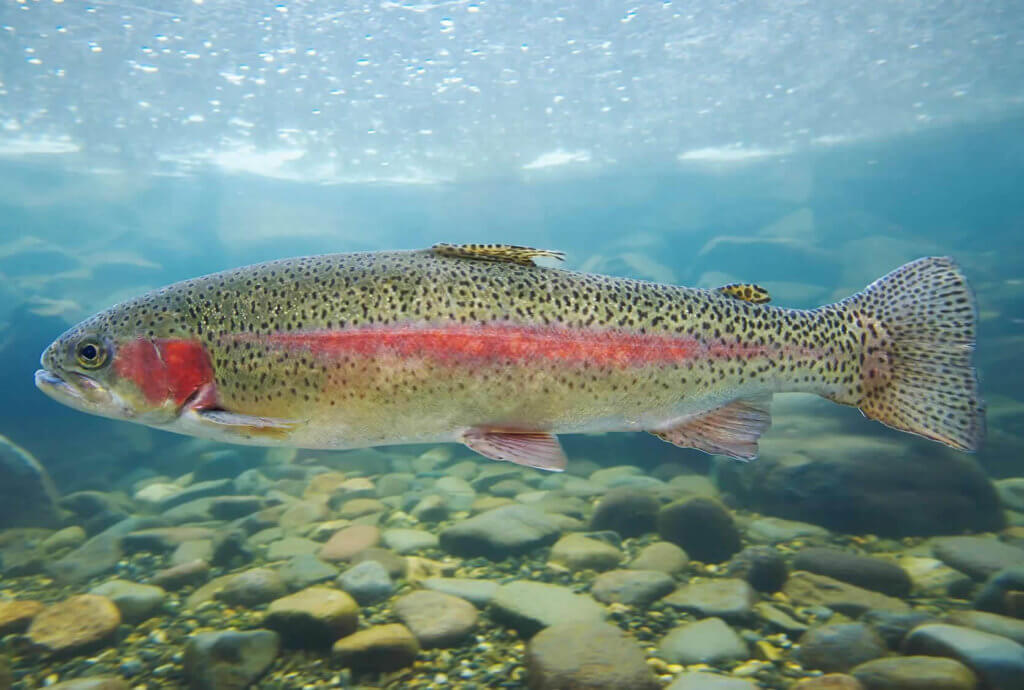
Trout are an important part of many ecosystems, as they serve as both predator and prey. They are also an important food source for many animals, including humans.
When fishing for trout, it’s important to use appropriate tackle and techniques. This can vary depending on the species of trout, the body of water you’re fishing in, and other factors. It’s important to check local fishing regulations and obtain any necessary licenses or permits before fishing for trout.
Species
Here’s a brief overview of some of the different trout species:
- Rainbow Trout. This is perhaps the most well-known species of trout. They are native to the western United States, but have been introduced to many other areas around the world. Rainbow trout are known for their colorful appearance and acrobatic fighting ability.
- Brown Trout. Brown trout are native to Europe, but have been introduced to many other areas around the world, including the United States. They are known for their cautious behavior and can be challenging to catch.
- Brook Trout. Brook trout are native to eastern North America, but can also be found in some western areas. They are known for their distinctive appearance, with a dark green back and sides and a lighter belly. Brook trout are typically found in small, clear streams.
- Cutthroat Trout. Cutthroat trout are native to western North America, and are named for the distinctive red “cutthroat” mark on their throat. They are typically found in cold, clear streams and rivers.
- Lake Trout. As the name suggests, lake trout are typically found in large lakes, although they can also be found in some rivers. They are a slow-growing species and can live for many years. Lake trout are typically caught using deep-water trolling techniques.
Each species of trout has its own unique characteristics and habitat preferences, which makes them interesting to fish for and study.
Appearance
Trout come in a range of sizes and colors, depending on the species, habitat, and other factors.
Here are some general characteristics of trout appearance:
- Trout have a streamlined body shape, with a pointed head and a tapered tail.
- They typically have a colorful appearance, with hues of green, brown, and silver, as well as spots and other markings.
- The fins of a trout are typically large and well-developed, with the tail fin being forked.
- Trout have small scales that are embedded in their skin.
- Depending on the species, trout can range in size from a few inches to several feet in length.
- Some trout species, such as rainbow trout, can have a distinctive pink or reddish stripe along their sides.
Trout are well-adapted to their aquatic environments, with their sleek body shape and powerful fins allowing them to swim quickly and maneuver through swift currents. Their colorful appearance also helps to camouflage them from predators or blend into their surroundings when hunting prey.
Size and weight
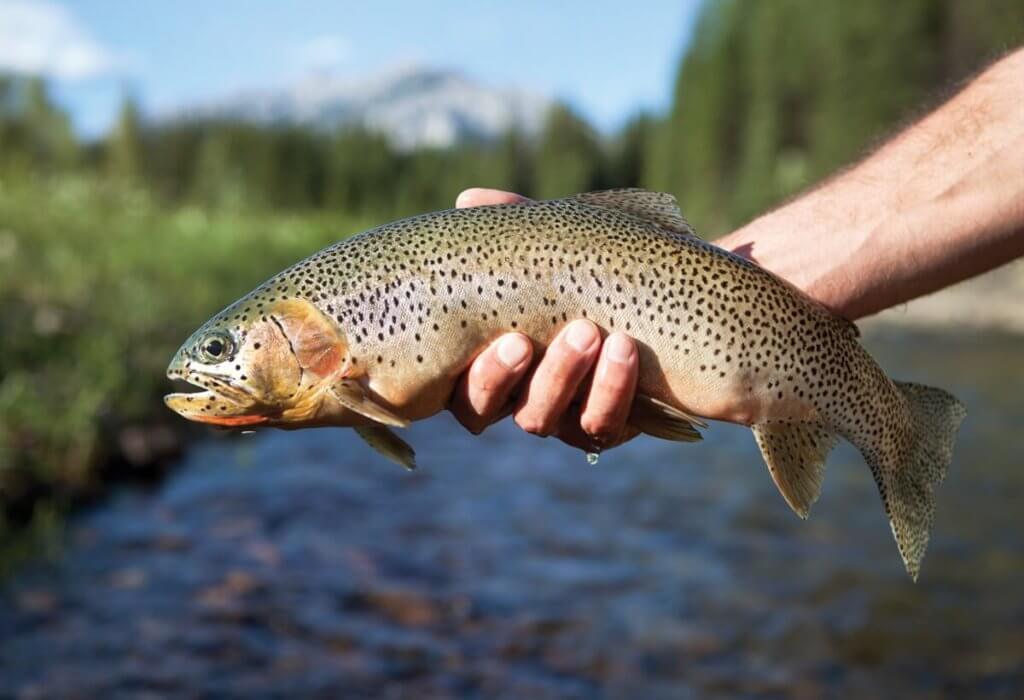
The size and weight of trout can vary greatly depending on the species, habitat, and other factors.
Here are some general size and weight ranges for some common trout species:
- Rainbow Trout. Rainbow trout can range in size from a few inches to over 30 inches in length, and can weigh anywhere from a few ounces to over 20 pounds.
- Brown Trout. Brown trout can also range in size from a few inches to over 30 inches in length, and can weigh anywhere from a few ounces to over 40 pounds (although this is rare).
- Brook Trout. Brook trout are typically smaller than other trout species, ranging in size from a few inches to around 16 inches in length. They typically weigh less than a pound.
- Cutthroat Trout. Cutthroat trout can range in size from a few inches to over 30 inches in length, and can weigh anywhere from a few ounces to over 20 pounds.
- Lake Trout. Lake trout are typically larger than other trout species, ranging in size from a few pounds to over 50 pounds. They can reach lengths of several feet.
It’s important to note that size and weight can vary greatly depending on the specific body of water you’re fishing in, as well as other factors such as water temperature, food availability, and fishing pressure. Additionally, many areas have regulations in place regarding the size and number of trout that can be kept, so be sure to check local fishing regulations before heading out.
Diet
Trout are carnivorous and feed on a variety of prey, including insects, crustaceans, and small fish.
Here are some more details on the diet of trout:
- Insects. Many species of trout, including rainbow, brown, and cutthroat trout, feed heavily on insects such as mayflies, caddisflies, and stoneflies. They will often feed on insects that are hatching on the surface of the water, as well as nymphs and larvae that are found underwater.
- Crustaceans. Crayfish and other small crustaceans are also an important part of the diet of some trout species, including brown and brook trout.
- Small fish. Larger trout will sometimes feed on small fish such as minnows or other trout. Lake trout, in particular, are known for feeding on small fish.
Trout are opportunistic feeders and will often adjust their diet based on the availability of prey in their environment. For example, in a stream or river with a high population of insects, a trout may feed almost exclusively on insects. In a lake or pond with a large population of small fish, a trout may switch to feeding primarily on fish.
When fishing for trout, it’s important to use lures or baits that mimic the types of prey that the trout are feeding on in that particular body of water. This can increase your chances of catching fish and make your fishing experience more enjoyable.
Behavior
Trout behavior can vary depending on the species, habitat, and other factors, but here are some general behaviors that are common among most trout:
- Feeding behavior. Trout are active feeders and will often feed during the early morning and late afternoon hours. They may also feed during overcast or rainy conditions. Trout will typically move to areas where food is abundant, such as riffles or pools in a stream, or near drop-offs or underwater structure in a lake.
- Territorial behavior. Trout can be territorial and will defend their feeding and spawning areas from other fish. This can sometimes make them difficult to catch, as they may be wary of lures or baits that they don’t recognize as natural prey.
- Spawning behavior. During the spawning season, which typically occurs in the fall, trout will migrate to shallow, gravelly areas of a stream or river to lay their eggs. Male trout will often become more aggressive during this time, as they compete for access to females.
- Habitat preferences. Different species of trout have different habitat preferences, but they are generally found in clear, cold water with ample oxygen and cover such as rocks, logs, or undercut banks. Trout will often move to different areas of a stream or lake depending on the time of day, water temperature, or the availability of food.
- Sensitivity to environmental changes. Trout are sensitive to changes in their environment and can be affected by factors such as water temperature, pollution, and habitat destruction. As a result, many areas have regulations in place to protect trout populations and their habitats.
Understanding trout behavior can be important for successful fishing, as it can help you identify areas where fish are likely to be found and choose the right lures or baits to use. It’s also important to practice responsible fishing techniques, such as catch-and-release fishing and following local fishing regulations, to help protect trout populations for future generations.
Spawning
Trout spawn in the fall in freshwater streams and rivers, and the spawning behavior can vary depending on the species of trout.
Here is a general overview of the spawning process for trout:
- Mating. During the spawning season, male and female trout migrate to shallow, gravelly areas of a stream or river to mate. Male trout will establish territories and defend them from other males, and will also court female trout by swimming alongside them and nudging them with their noses.
- Egg-laying. Once a female trout has selected a suitable spot to lay her eggs, she will dig a depression in the gravel with her tail and deposit her eggs. Male trout will then fertilize the eggs by releasing sperm over them.
- Incubation. Trout eggs will incubate in the gravel for several weeks before hatching. The incubation time can vary depending on the water temperature, with warmer water resulting in faster hatching times.
- Fry emergence. Once the eggs hatch, the young trout, called fry, will emerge from the gravel and begin feeding on small aquatic insects and other prey. Fry are small and vulnerable at this stage, and are often preyed upon by larger fish and birds.
- Juvenile growth. As the fry grow and develop, they will move to deeper areas of the stream or river and begin feeding on larger prey. Over time, they will mature into adult trout and begin the spawning process themselves.
It’s important to note that trout spawning is a delicate process and can be easily disrupted by human activities such as dam construction, pollution, and habitat destruction. As a result, many areas have regulations in place to protect spawning trout populations and their habitats. If you’re fishing during the spawning season, it’s important to be aware of these regulations and to practice responsible fishing techniques to help protect trout populations for future generations.
Fishing
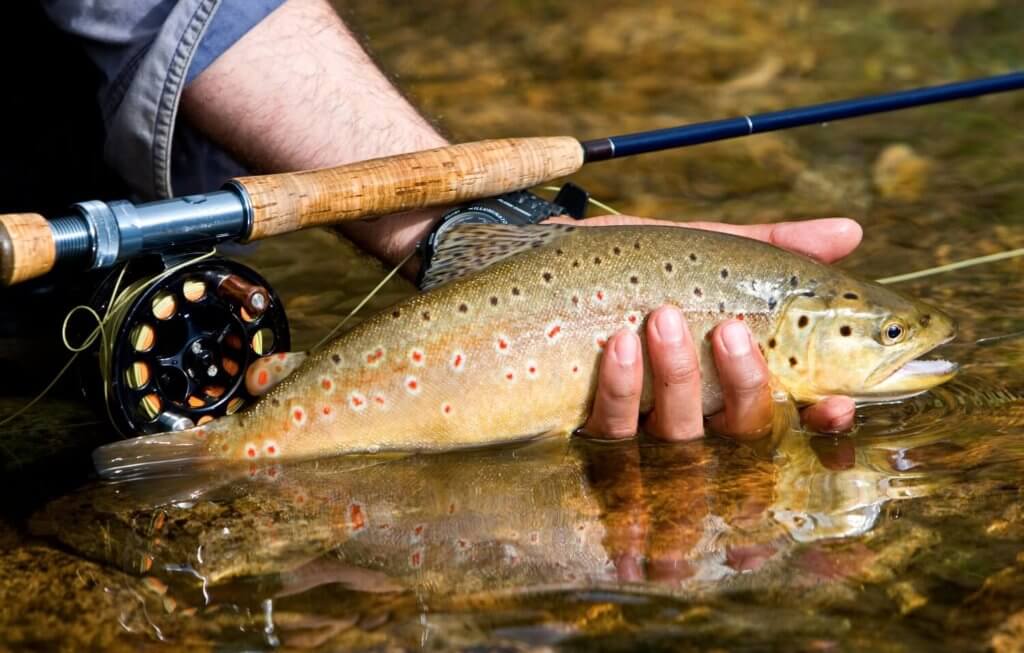
Fishing for trout is a popular pastime that can be enjoyed in a variety of settings, from mountain streams to large lakes.
Here are some general tips for fishing for trout:
- Choose the right gear. The gear you use for trout fishing will depend on the type of water you’ll be fishing in, the size of the trout you’re targeting, and your personal preferences. Generally, a lightweight rod and reel combo with a 4-8 pound test line is suitable for most trout fishing situations. You’ll also want to choose lures or baits that are appropriate for the type of trout you’re fishing for and the conditions you’ll be fishing in.
- Know the regulations. Many areas have fishing regulations in place to protect trout populations and their habitats. Before you go fishing, be sure to familiarize yourself with the local regulations and obtain any necessary licenses or permits.
- Observe the water. Look for areas of the water where trout are likely to be found, such as riffles or pools in a stream, or near drop-offs or underwater structure in a lake. You can also look for signs of feeding activity, such as rises or splashes on the surface of the water.
- Use the right technique. Depending on the type of water you’re fishing in and the type of lure or bait you’re using, there are a variety of techniques you can use to catch trout. Some common techniques include fly fishing, spin fishing, and bait fishing. Experiment with different techniques to see what works best in the conditions you’re fishing in.
- Practice catch-and-release. If you catch a trout that you don’t plan on keeping, it’s important to handle it carefully and release it quickly to minimize stress and increase its chances of survival. Use barbless hooks and avoid lifting the fish out of the water if possible.
By following these tips and practicing responsible fishing techniques, you can enjoy a rewarding and sustainable trout fishing experience.
Lures
Trout can be caught using a variety of lures, each of which is designed to mimic a different type of prey.
Here are some popular types of lures for trout fishing:
- Spinners. Spinners are small, metal lures with a spinning blade that creates vibration and flash in the water. They come in a variety of sizes and colors, and can be used to imitate a range of prey, from minnows to insects.
- Jigs. Jigs are small, weighted lures with a hook that can be tipped with a soft plastic bait or a piece of live bait. They are designed to be bounced along the bottom or retrieved through the water column to mimic a small baitfish or insect.
- Crankbaits. Crankbaits are hard-bodied lures with a diving lip that causes them to dive and wiggle through the water. They come in a variety of shapes, sizes, and colors, and can be used to imitate a range of prey, from crawfish to small fish.
- Flies. Fly fishing is a popular method for trout fishing, and involves using artificial flies made from feathers, fur, and other materials to imitate insects or other prey. Different types of flies are used to mimic different stages of insect life cycles, and can be fished on the surface or subsurface of the water.
- Soft plastics. Soft plastic lures, such as grubs and worms, can be rigged on a jig head or fished weightless to imitate a range of prey, from insects to small fish. They come in a variety of colors and sizes, and can be effective in both still and moving water.
When choosing a lure for trout fishing, it’s important to consider the water conditions and the type of prey that the trout are likely feeding on. By matching your lure to the conditions and the prey, you can increase your chances of catching a trout.
Here are some examples of popular fishing lures for trout, along with their models and specifications:
- Mepps Aglia Spinner: The Mepps Aglia Spinner is a classic spinner lure that comes in a variety of sizes and colors. It features a French blade that spins and creates flash and vibration in the water, and can be fished at a variety of depths. The Mepps Aglia Spinner is effective for a range of trout species, including rainbow trout and brown trout.
- Rebel Wee Crawfish: The Rebel Wee Crawfish is a crankbait lure that mimics a small crawfish. It features a diving lip that causes it to dive and wiggle through the water, and can be fished at a variety of depths. The Rebel Wee Crawfish is effective for catching trout in streams and rivers, especially in areas where crawfish are a natural prey.
- Rapala Ultra Light Minnow: The Rapala Ultra Light Minnow is a small crankbait lure that mimics a small minnow or baitfish. It features a swimming action that imitates the movement of a real fish, and can be fished at a variety of depths. The Rapala Ultra Light Minnow is effective for catching trout in both still and moving water.
- Berkley Gulp! Floating Trout Worm: The Berkley Gulp! Floating Trout Worm is a soft plastic lure that mimics a small worm or insect. It can be rigged on a jig head or fished weightless, and can be effective in both still and moving water. The Berkley Gulp! Floating Trout Worm is scented to attract trout, and comes in a variety of colors.
- Blue Fox Vibrax Spinner: The Blue Fox Vibrax Spinner is a spinner lure that features a rotating blade and a vibrating body that creates flash and vibration in the water. It comes in a variety of sizes and colors, and can be fished at a variety of depths. The Blue Fox Vibrax Spinner is effective for catching a range of trout species, including brook trout and cutthroat trout.
- PowerBait Trout Bait: This bait is specially designed for Trout and is known for its effectiveness. It comes in different colors, but the most popular are rainbow and chartreuse. The bait is made of a floating formula that imitates the scent and taste of real bait. It can be used with a variety of fishing techniques such as drift fishing, still fishing, and trolling.
- Panther Martin Spinner: This is a classic Trout fishing bait that has been around for over 50 years. It is a small, lightweight lure that is easy to cast and retrieve. The spinner blade creates a lot of flash and vibration in the water, which attracts the attention of Trout. It comes in a variety of colors and sizes, but the most popular are black and gold.
- Rooster Tail Spinner: Another popular spinner for Trout fishing is the Rooster Tail. It has a unique spinning action that creates a lot of flash and vibration in the water. The bait is designed to look like a small fish or insect, which makes it irresistible to Trout. It comes in a variety of colors and sizes, but the most popular are yellow and white.
- Berkley Gulp Alive Trout Bait: This bait is made of a biodegradable material that imitates the scent and taste of real bait. It can be used with a variety of fishing techniques such as drift fishing, still fishing, and trolling. The bait comes in a variety of colors, but the most popular are natural and chartreuse. It is also infused with a scent attractant that makes it even more irresistible to Trout.
When selecting a fishing lure for trout, it’s important to consider the size, color, and action of the lure, as well as the water conditions and the natural prey that the trout are likely feeding on. By matching your lure to the conditions and the prey, you can increase your chances of catching a trout.
Baits
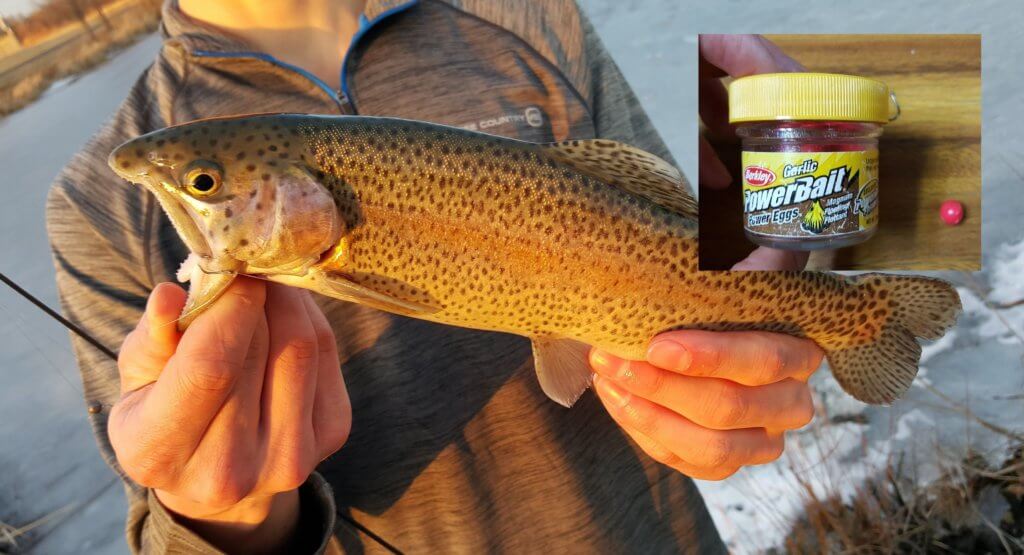
In addition to lures, there are also several types of baits that can be used for trout fishing.
Here are some common baits used for catching trout:
- Worms. Nightcrawlers, red worms, and garden worms are all popular choices for bait when targeting trout. These baits can be fished on a hook with or without a weight, and can be effective in both still and moving water.
- Powerbait. Powerbait is a type of dough bait that is designed to imitate the scent and texture of natural bait. It comes in a variety of colors and flavors, and can be effective for catching stocked trout. Powerbait is best fished on a small treble hook with a weight, and can be fished on the bottom or suspended off the bottom with a bobber.
- Salmon Eggs. Salmon eggs, or roe, can be an effective bait for catching trout, especially in streams and rivers where salmon are spawning. Fresh or cured salmon eggs can be fished on a small hook with a weight, and can be fished on the bottom or suspended off the bottom with a bobber.
- Minnows. Live minnows can be an effective bait for catching larger trout in lakes and ponds. Minnows can be fished on a hook with a weight or a bobber, and can be retrieved slowly to imitate the movement of a live fish.
- Insects. Insects, such as grasshoppers, crickets, and ants, can be an effective bait for catching trout, especially in late summer and early fall. These baits can be fished on a hook with or without a weight, and can be effective in both still and moving water.
When selecting a bait for trout fishing, it’s important to consider the water conditions and the natural prey that the trout are likely feeding on. By matching your bait to the conditions and the prey, you can increase your chances of catching a trout.
Rods
Trout fishing rods are specialized fishing rods designed for anglers who target trout species. These rods are usually lightweight and flexible, allowing anglers to feel the slightest bite and to cast lures or baits accurately.
Here are some of the details you may want to consider when looking for a trout fishing rod:
- Length. Trout fishing rods usually range in length from 6 to 9 feet. A shorter rod will be more accurate and easier to handle in small streams and creeks, while a longer rod will provide more casting distance in larger rivers and lakes.
- Power. Trout rods are usually classified as light to ultralight power, which refers to the rod’s ability to bend and flex under pressure. A light power rod is more flexible and ideal for small trout, while an ultralight power rod is even more sensitive and suitable for catching smaller fish.
- Action. The action of a fishing rod refers to the speed at which the rod bends and flexes. A fast action rod bends primarily in the upper third of the rod, making it more sensitive and ideal for making long casts with small lures. A slow action rod bends more in the lower half of the rod, making it more forgiving and better suited for fishing in small streams and creeks.
- Material. Trout fishing rods can be made from a variety of materials, including graphite, fiberglass, and bamboo. Graphite is the most popular material due to its sensitivity and light weight.
- Handle. The handle of a trout fishing rod can be made from cork, foam, or rubber. Cork handles are popular due to their comfortable grip and lightweight design.
Overall, when choosing a trout fishing rod, it’s important to consider the size of the fish you’re targeting, the type of water you’ll be fishing in, and your personal preferences for rod length, power, action, and material.
Here are a few examples of trout fishing rods with their models and specifications:
- G. Loomis E6X Trout – This is a fast action, lightweight rod made from high-quality graphite. It comes in lengths of 7’0″, 7’6″, and 8’0″, with power ratings of ultra-light to medium. The handle is made from premium cork, and the guides are Fuji aluminum oxide.
- St. Croix Trout Series – This series of rods is designed specifically for trout fishing, with models ranging from 5’0″ to 7’6″ in length and power ratings of ultra-light to medium-light. The rods are made from premium SCII graphite and feature Fuji DPS reel seats and Kigan Master Hand 3D guides.
- Fenwick AETOS Trout – The Fenwick AETOS Trout is a fast action rod made from high-quality graphite. It comes in lengths of 7’0″ and 8’0″, with power ratings of ultra-light and light. The handle is made from AAA cork, and the guides are Fuji stainless steel.
- Orvis Clearwater Trout – This is a medium action rod made from high-modulus graphite. It comes in lengths of 7’0″, 7’6″, and 8’6″, with power ratings of ultra-light to medium. The handle is made from cork, and the guides are chrome snake guides with a stripping guide.
- Sage Trout LL – The Sage Trout LL is a medium-action rod made from high-quality graphite. It comes in lengths of 7’9″ and 8’6″, with power ratings of ultra-light and light. The handle is made from premium cork, and the guides are Fuji ceramic stripper guides and hard chrome snake guides.
Dishes
Trout is a delicious and healthy fish that can be prepared in a variety of ways.
Here are some popular dishes that can be made with trout:
- Grilled Trout – Grilling trout is a popular and easy way to prepare it. Simply clean and gut the fish, brush with olive oil, season with salt and pepper, and grill for about 5-7 minutes on each side, until the skin is crispy and the meat is cooked through.
- Baked Trout – Baking trout is another easy and delicious way to prepare it. Stuff the trout with herbs, lemon slices, and butter, season with salt and pepper, and bake at 375°F for about 20-25 minutes, until the fish is cooked through and flaky.
- Pan-Fried Trout – Pan-frying trout is a classic preparation that results in crispy skin and tender meat. Coat the trout in seasoned flour, heat some butter or oil in a pan, and cook the fish for about 3-4 minutes on each side, until golden brown and cooked through.
- Trout Almondine – Trout almondine is a classic French preparation that involves pan-frying trout and serving it with a brown butter and almond sauce. Coat the trout in flour, pan-fry it in butter, and then top it with a sauce made from browned butter, sliced almonds, lemon juice, and parsley.
- Smoked Trout – Smoking trout is a great way to infuse it with flavor and preserve it for later use. Brine the trout in a mixture of salt, sugar, and spices, smoke it over wood chips for several hours, and then store it in the refrigerator or freezer.
These are just a few examples of the many delicious dishes that can be made with trout. Experiment with different flavors and preparations to find your favorite way to enjoy this versatile fish.

